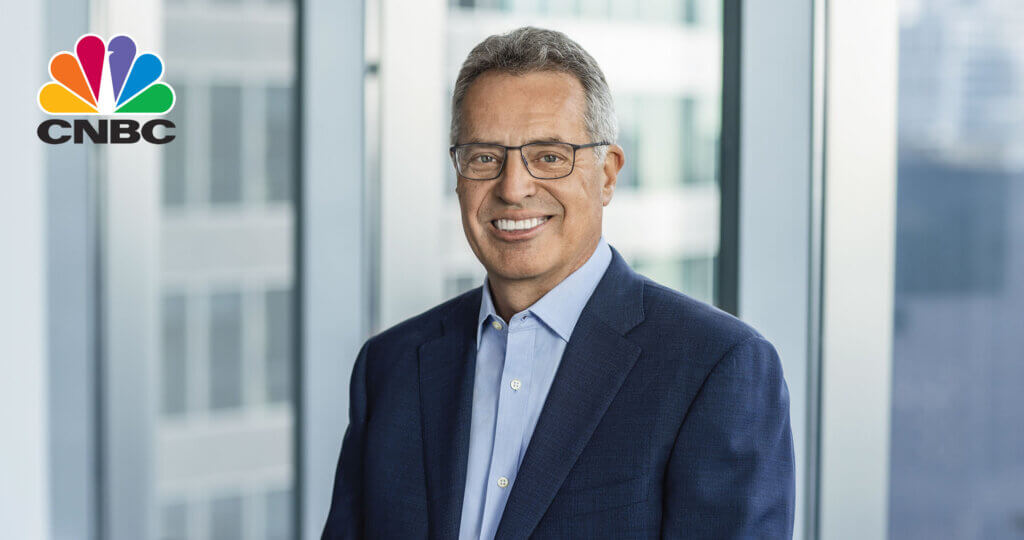Oakmark Fund - Investor Class
Average Annual Total Returns 09/30/2025
Since Inception 08/05/91 12.80%
10-year 13.70%
5-year 19.02%
1-year 11.13%
3-month 3.18%
Expense Ratio: 0.89%
Oakmark Select Fund - Investor Class
Since Inception 11/01/1996 11.76
10-year 10.44
5-year 17.66
1-year 11.72
3-month 2.34
Expense Ratio: 0.99%
Expense ratios are as of the Fund’s most recent prospectus dated January 28, 2025, as amended and restated January 30, 2025, March 14, 2025 and May 19, 2025; actual expenses may vary.
Past performance is no guarantee of future results. The performance data quoted represents past performance. Current performance may be lower or higher than the performance data quoted. The investment return and principal value vary so that an investor’s shares when redeemed may be worth more or less than the original cost. To obtain the most recent month-end performance data, view it here.
A year ago, we asked for your questions, and the response was so strong that we decided to ask more frequently. Last month, you submitted over 60 questions. Some covered similar ground, so I’ve taken the liberty of rewriting and combining them to answer as many as possible. Special thanks to those who suggested improvements for our website, online account access and telephone service. We strive to excel in both customer service and investment results. Knowing where we fall short is the first step to improving, so thank you! And next time you see something we can do better, please let us know right away.
Your questions fell into three broad categories: differences between our funds, the current market environment, and portfolio holdings. Let’s start with the various Oakmark funds.
Which should produce the highest after-tax return: a separate account or the Oakmark Fund?
Separate accounts offer personalized service, tailored portfolios, gifting of appreciated securities, and tax-loss harvesting, which can shelter gains from other investments. But at our firm, both invest from the same list of approved stocks, so their pretax returns should be similar. Mutual funds have tax advantages, including being taxed on net rather than gross investment income (meaning management fees are effectively tax deductible). At Oakmark, we have used a variety of tools to defer capital gain distributions. For example, the Oakmark Fund has increased by 77% in the past four years yet has not paid a capital gain distribution since 2021 and won’t this year. Separate account managers may not have access to the same tools and therefore may not have the same success in deferring gains as investors in the Oakmark funds have had.
Why doesn’t Oakmark Fund pay capital gains dividends like my other funds? By reinvesting them, I increase the number of shares I own, and I can’t do that with Oakmark.
We view it as a feature, not a bug. When funds make capital gain distributions, their per-share value declines, offsetting the number of new shares you receive. But you have to pay tax on the capital gain. When we avoid making distributions, you continue earning a return on the money that would otherwise have gone to taxes. The closer we can get to deferring all capital gains until you sell your Oakmark shares, the higher your after-tax return will be.
Since ETFs are so tax efficient, why would anyone buy Oakmark Fund instead of Oakmark U.S. Large Cap ETF?
We expect both funds to deliver similar tax efficiency. Advantages of the mutual fund include: the ability to transact at NAV instead of paying a bid/ask spread, access to somewhat smaller market-cap companies, and lower volatility due to a higher number of holdings. The ETF offers live price quotes and intraday liquidity and has greater concentration in our highest conviction holdings. Note that the ETF has performed better than Oakmark Fund this year, but we don’t believe the magnitude of outperformance is sustainable.
Oakmark Fund always lags behind its benchmarks. Why shouldn’t I just own an index fund?
We share your frustration that the Oakmark Fund has lagged behind its benchmarks in 2025. However, the Oakmark Fund has performed better than the S&P 500 Index for the past five-year period, and it has outperformed the Russell 1000 Value Index for the past 1, 3, 5 and 10 years.
The S&P 500 has been difficult to beat because of its heavy weighting in technology stocks that have performed incredibly well. We added the Russell 1000 Value as a secondary benchmark several years ago because we were concerned that the S&P 500 was becoming a riskier portfolio than is appropriate for most investors. It has effectively become a highly concentrated, technology growth fund. Although investors have enjoyed the increased volatility on the way up, they need to be aware that the risk goes in both directions.
The Oakmark Fund owns a different portfolio than the S&P 500. The P/E is much lower (about 12 compared to 24), diversification is much higher (largest position 3.5% vs. over 7%) and direct exposure to technology is much smaller (4% vs. 35%). Generally speaking, adding Oakmark Fund to a portfolio that includes the S&P 500 will improve diversification, which can reduce risk.
Oakmark Select Fund never does as well as Oakmark Fund. Why bother with it?
Oakmark Select represents our highest conviction investments, so it is especially frustrating when it lags behind a more diversified portfolio. I’ve written a lot on this topic (you can read here and here), but I’ll summarize. Oakmark Select can invest in smaller companies than Oakmark, which should create a long-term advantage but has hurt recent performance. Further, Oakmark Select tends to outperform Oakmark when Oakmark is outperforming the S&P 500. With growth performing so much better than value for the past decade, our highest conviction holdings have not been our best performers. We expect that to reverse when value outperforms growth. $10,000 invested in Oakmark Select at its 1996 inception has grown to $248,989 while the same investment in Oakmark Fund grew to $159,910. Over the long term, concentration has added significant value.
We are approaching retirement and no longer have the long-term horizon we had when we first bought the Oakmark Fund. Do you have other funds that might be more appropriate for us?
Yes, we do. As life circumstances change, so does the appropriate percentage of assets exposed to stock market volatility. It’s prudent to reduce investments in stocks as one gets closer to spending that money. We manage two lower risk funds at Oakmark. The Oakmark Equity and Income Fund blends a portfolio of stocks and bonds, which has resulted in lower volatility than the Oakmark Fund since inception. The Oakmark Equity and Income Fund typically holds about 60% of its assets in stocks and the other 40% in bonds. For those who don’t want to spend time thinking about investing, it can be a good solution.
For those who are more hands-on, the Oakmark Bond Fund invests in bonds using the same value philosophy we use in equities. The Fund had its fifth anniversary earlier this year and has earned Morningstar’s 5-star ranking1. Selling some Oakmark Fund to buy Oakmark Bond Fund would also reduce your exposure to equity market volatility.
With economic collapse inevitable because of how inept Trump is, won’t the market crash? With the U.S. economy on the cusp of a Trump boom, doesn’t the market have to go up?
Oakmark has thrived over its 34-year history by being apolitical. The economy and the stock market have both gone up with both Republicans and Democrats in power, and we expect that to continue. Economic forces are stronger and last longer than political forces. When policy turns out to be as bad as feared, it usually self-corrects, as the next elections are never far off. Despite the difficulties the world has faced since we started Oakmark Fund 34 years ago, the S&P has increased 30-fold, and Oakmark has nearly doubled that. We don’t think it pays to predict when the market might decline.
The S&P 500 looks way overvalued. Shouldn’t we be selling?
The S&P 500 is currently selling at about 24 times expected earnings compared to its historical average of about 17 times. That makes it easy to conclude the market is overvalued. However, the expected growth in S&P 500 earnings has also risen. A decade ago, expectations were that its earnings would grow at about 7% per year. Today, that number is double digits due to mega-cap tech companies. Never have we seen such large companies accelerate their growth as they get larger, and that has produced strong earnings and stock prices. The S&P 500 has become a growth fund, and growth funds deserve to sell at higher multiples. A broader index like the Russell 1000 Value, which now includes more above-average-growth businesses than ever, both looks like and is priced like the S&P 500 was a few years ago. We don’t believe that stocks are necessarily overvalued, but the S&P 500 has certainly become more volatile due to its technology concentration.
Are you worried that interest rates are too high/low? Won’t higher/lower rates be bad/good for stocks? Inflation is inevitably going higher/lower. What does that mean for our portfolio?
Our shareholders may hold different views, but neither side lacks conviction! We think current interest rates provide a roughly appropriate premium above expected inflation. The stock market tends to increase when rates decline and vice versa, but there is an offset because rates tend to move in the opposite direction of the economy. Stocks have historically been a good hedge against inflation, and if inflation does go higher than current expectations, stocks are likely to protect your capital better than cash or bonds. Higher inflation would be good for some of our holdings, especially the natural resource stocks.
Why are we invested in oil and gas companies, given how bad they are for the environment and the inevitable conversion to electric vehicles?
We expect the conversion to an all-electric fleet is many years off, a conclusion the auto industry has also reached. Reduced charge time and improvements in the charging infrastructure are likely needed before Middle America will give up its internal-combustion vehicles. On the environmental side, we take comfort that U.S. energy companies produce much less carbon than their global competitors. The gain in the U.S. share of oil production has meaningfully reduced global emissions. We own these stocks because they mostly trade at single-digit P/Es based on $70 oil, and unlike the past when every spare dollar went into exploration, the companies are now returning most of their earnings to shareholders.
Why do we own so many banks?
In general, banks sell at barely double-digit P/Es, are more conservatively managed than they were in the past (more capital, better liquidity, higher reserves) and are returning most of their earnings to shareholders. If a bank can grow earnings in line with GDP (say 4% nominal), reduce the share count by 5% annually and pay a 3% yield, that would total a 12% annual return. We think that beats most other opportunities.
Why do we still own Alphabet? Won’t AI spending hurt margins? Won’t AI kill search?
First, we have reduced the number of Alphabet shares Oakmark Fund owns by almost 20% compared to a year ago, but its strong market performance has largely offset our selling, keeping it a top holding.
Alphabet has been spending heavily on AI for several years. We see the payoff in the rapid growth of Google Cloud Services and in the reduction of operating expenses. This spending caused depreciation expense to increase from 3.7% to 5.3% of revenue over the past two years. Yet Alphabet’s operating margins have improved by 4 percentage points in that time. We expect this trend to continue.
We’ve owned Alphabet for about 12 years, and ChatGPT is the first competitive threat in search that has concerned us. There are many reasons Google could continue its dominance, including the ease of getting its own high-quality AI-assisted results for free. But we acknowledge the risk has grown. Offsetting that is growth in other businesses such as Google Cloud, which is growing faster as AI growth accelerates, YouTube, which now has 50% more viewing hours than Netflix, and Waymo, which has arguably regained the top spot in autonomous driving. With the stock selling at about a market multiple, before adjusting for its high cash balance and its venture capital losses that depress current earnings, we believe the risks are priced in.
How are you implementing AI?
It is still early, but we are building out a quantitative team to help accelerate our use of AI and other quantitative tools. We’ve input our proprietary research into an AI database that is easily searchable, which is increasing efficiency. We are using AI to scan and summarize lengthy reports and to keep us informed of news across industries we are invested in. We are building tools that will help us identify any consistent biases in our research and portfolio construction.
Why don’t we own Nvidia/Costco/various AI plays/Crypto, etc.?
We don’t comment on investments that we don’t own. However, if you think about what value investing is—buying only at a discount to intrinsic business value—you can guess why we don’t own them. Either they are very good businesses that the market is appropriately pricing as very good businesses, or other investors are willing to project higher growth farther into the future than we are, or the intrinsic value is challenging to determine, which means we can’t be confident in our estimate. This question brought to mind a Simpsons cartoon that shows how I feel when I talk to people who have only been watching the market for the past decade—when seemingly all that mattered was identifying good companies and not worrying about their prices.

“We used to care about valuation multiples for our investments!”
Thank you again for the great questions and for your interest and investments in our funds.
OPINION PIECE. PLEASE SEE ENDNOTES FOR IMPORTANT DISCLOSURES.
Important Disclosures
1Morningstar star rating portrays the Overall Morningstar Rating for Oakmark Bond Fund (Institutional Share Class) in the Intermediate Core-Plus Bond fund category out of 468 funds as of 9/30/2025 based on risk-adjusted returns; other classes may have different performance characteristics and star ratings. The Fund’s 5-year Morningstar Rating is also 5 Stars out of 468 funds.
For each fund with at least a three-year history, Morningstar calculates a Morningstar Rating based on a Morningstar Risk-Adjusted Return measure that accounts for variation in a fund’s monthly performance (including the effects of sales charges, loads, and redemption fees), placing more emphasis on downward variations and rewarding consistent performance. The top 10% of funds in each category receive 5 stars, the next 22.5% receive 4 stars, the next 35% receive 3 stars, the next 22.5% receive 2 stars and the bottom 10% receive 1 star. (Each share class is counted as a fraction of one fund within this scale and rated separately, which may cause slight variations in the distribution percentages.) The Overall Morningstar Rating for a fund is derived from a weighted average of the performance figures associated with its three-, five- and ten-year (if applicable) Morningstar Rating metrics. As of 9/30/25, Oakmark Bond Fund – Institutional Share Class OANCX was rated against 486, U.S. domiciled funds in the Intermediate Core-Plus Bond category and received 5 stars for the 5-year period. Past performance is no guarantee of future results. © 2025 Morningstar, Inc. All Rights Reserved. The information contained herein: (1) is proprietary to Morningstar; (2) may not be copied or distributed; and (3) is not warranted to be accurate, complete or timely. Neither Morningstar nor its content providers are responsible for any damages or losses arising from any use of this information.
The securities mentioned above comprise the following percentages of the Oakmark Fund’s total net assets as of 09/30/2025: Alphabet 3.5x%, Costco 0%, Netflix 0% and Nvidia 0%. Portfolio holdings are subject to change without notice and are not intended as recommendations of individual stocks. The Funds disclaim any obligation to advise shareholders of such changes. Information about portfolio holdings does not represent a recommendation or an endorsement to Fund shareholders or other members of the public to buy or sell any security contained in the Funds’ portfolios. Portfolio holdings are current to the date listed but are subject to change any time. There are no assurances that the securities will remain in the Funds’ portfolios after the date listed or that the securities that were previously sold may not be repurchased.
Access the full list of holdings for the Oakmark Fund here.
The information, data, analyses, and opinions presented herein (including current investment themes, the portfolio managers’ research and investment process, and portfolio characteristics) are for informational purposes only and represent the investments and views of the portfolio managers and Harris Associates L.P. as of the date written and are subject to change and may change based on market and other conditions and without notice. This content is not a recommendation of or an offer to buy or sell a security and is not warranted to be correct, complete or accurate.
Certain comments herein are based on current expectations and are considered “forward-looking statements.” These forward looking statements reflect assumptions and analyses made by the portfolio managers and Harris Associates L.P. based on their experience and perception of historical trends, current conditions, expected future developments, and other factors they believe are relevant. Actual future results are subject to a number of investment and other risks and may prove to be different from expectations. Readers are cautioned not to place undue reliance on the forward-looking statements.
This material is not intended to be a recommendation or investment advice, does not constitute a solicitation to buy, sell or hold a security or an investment strategy, and is not provided in a fiduciary capacity. The information provided does not take into account the specific objectives or circumstances of any particular investor, or suggest any specific course of action. Investment decisions should be made based on an investor’s objectives and circumstances and in consultation with his or her financial professionals.
Open-end mutual funds and Exchange Traded Funds (ETFs) are investment vehicles with both similarities and differences. Investors should read offering documents and consult a financial or tax advisor before investing. Some differences include: ETF Expenses: Expense ratio – Annual fee covering fund management and operations. Commissions – Fees for buying or selling ETFs, though many brokers offer commission free trades. Mutual Fund Expenses: Sales loads – Commissions paid when buying (front-end load) or selling (back-end load) fund shares. Redemption fees – Charged when selling shares within a certain time frame. Purchase fees – Fees for buying shares, separate from sales loads. Exchange fees – Fees for switching between funds within the same family. Account fees – Maintenance fees for low balances or inactivity. Annual fund operating expenses – Management fees paid to the fund’s investment advisor, 12b-1 fees for marketing and distribution, and other expenses like legal, custodial, accounting, and administrative costs. Tax Implications: ETFs – Generally tax-efficient due to the in-kind creation/redemption process, with gains or losses realized only when selling an ETF. Mutual Funds – Redemptions can trigger portfolio trading, leading to tax implications for shareholders, including capital gains distributions. Buying and Selling: ETFs – Continuously priced throughout the trading day and traded in the secondary market via brokers, allowing limit, stop-limit, shortsale orders, and margin trading. Mutual funds – transacted with the mutual fund company or via a brokerage account, with orders placed during the business day and filled later using the closing price of securities. Pricing: ETFs – Share prices fluctuate during the day on a stock exchange and can trade at a premium or discount to the net asset value (NAV). Mutual Funds – All shareholder orders receive the same daily price—the NAV—calculated after the market closes. Holdings Disclosure: ETFs – Generally daily disclosure of portfolio holdings and estimated value of underlying holdings throughout trading hours. Mutual Funds – Generally delayed monthly or quarterly disclosure of portfolio holdings with daily disclosure of NAV performance.
Separately Managed Accounts (SMAs) are not subject to the Investment Company Act, unlike open end mutual funds and ETFs. SMAs allow investors to directly own the individual securities invested in, have fees that vary by provider, generally have higher minimum investment thresholds and may have a higher degree of customization versus mutual funds and ETFs.
The price-to-earnings ratio (“P/E”) compares a company’s current share price to its per-share earnings. It may also be known as the “price multiple” or “earnings multiple”, and gives a general indication of how expensive or cheap a stock is. Investors should not base investment decisions on any single attribute or characteristic data point.
A bid-ask spread is the difference between the ask price and the bid price for an asset in the marketplace. It shows the highest price that a buyer is willing to pay for a security and the lowest price that a seller is willing to accept.
Gross domestic product (GDP) is the total market value of all final goods and services produced in a country during a specific period, used as the primary indicator of economic health and performance.
Nominal means the growth rate that has not been adjusted for inflation.
The S&P 500 Index is a float-adjusted, capitalization-weighted index of 500 U.S. large-capitalization stocks representing all major industries. It is a widely recognized index of broad, U.S. equity market performance. Returns reflect the reinvestment of dividends. This index is unmanaged and investors cannot invest directly in this index.
Russell 1000® Value Index measures the performance of the large-cap value segment of the U.S. equity universe. It includes those Russell 1000® companies with lower price-to-book ratios and lower expected growth values. This index is unmanaged and investors cannot invest directly in this index.
Investing in value stocks presents the risk that value stocks may fall out of favor with investors and underperform growth stocks during given periods.
The Oakmark Fund’s portfolios tend to be invested in a relatively small number of stocks. As a result, the appreciation or depreciation of any one security held by the Fund will have a greater impact on the Fund’s net asset value than it would if the Fund invested in a larger number of securities. Although that strategy has the potential to generate attractive returns over time, it also increases the Fund’s volatility.
Because the Oakmark Select Fund is non-diversified, the performance of each holding will have a greater impact on the Fund’s total return, and may make the Fund’s returns more volatile than a more diversified fund. The securities of medium-sized companies tend to be more volatile than those of large companies and have underperformed the stocks of small and large companies during some periods.
The Oakmark Equity and Income Fund invests in medium- and lower-quality debt securities that have higher yield potential but present greater investment and credit risk than higher-quality securities. These risks may result in greater share price volatility. An economic downturn could severely disrupt the market in medium or lower grade debt securities and adversely affect the value of outstanding bonds and the ability of the issuers to repay principal and interest. Its portfolio tends to be invested in a relatively small number of securities. As a result, the appreciation or depreciation of any one security held by the Fund will have a greater impact on the Fund’s net asset value than it would if the Fund invested in a larger number of securities. Although that strategy has the potential to generate attractive returns over time, it also increases the Fund’s volatility. The securities of medium-sized companies tend to be more volatile than those of large companies and have underperformed the securities of small and large companies during some periods.
The Oakmark Bond Fund invests primarily in a diversified portfolio of bonds and other fixed-income securities. These include, but are not limited to, investment grade corporate bonds; U.S. or non-U.S.-government and government-related obligations (such as, U.S. treasury securities); below investment-grade corporate bonds; agency mortgage backed-securities; commercial mortgage- and asset-backed securities; senior loans (such as, leveraged loans, bank loans, covenant lite loans, and/or floating rate loans); assignments; restricted securities (e.g., Rule 144A securities); and other fixed and floating rate instruments. The Fund may invest up to 20% of its assets in equity securities, such as common stocks and preferred stocks. The Fund may also hold cash or short-term debt securities from time to time and for temporary defensive purposes.
Under normal market conditions, the Fund invests at least 25% of its assets in investment-grade fixed-income securities and may invest up to 35% of its assets in below investment-grade fixed-income securities (commonly known as “high-yield” or “junk bonds”). Fixed income risks include interest-rate and credit risk. Typically, when interest rates rise, there is a corresponding decline in bond values. Credit risk refers to the possibility that the bond issuer will not be able to make principal and interest payments. Bond values fluctuate in price so the value of your investment can go down depending on market conditions.
Oakmark U.S. Large Cap ETF: Investing involves risk; principal loss is possible. There is no guarantee the Fund’s investment objective will be achieved. The Fund is actively managed and does not seek to replicate a specific index. Exchange-Traded Fund (ETFs) are subject to additional risks that do not apply to conventional mutual funds, including the risks that the market price of ETF’s shares may trade at a premium or discount to its net asset value (NAV), an active secondary trading market may not develop or be maintained, or trading may be halted by the exchange in which they trade, which may impact an ETF’s ability to sell its shares. Unlike mutual funds, ETF shares are bought and sold at market price, which may be higher or lower than their NAV, and are not individually redeemed from the fund. Brokerage commissions will reduce returns. The Fund invests primarily in large capitalization securities, which may be unable to respond quickly to new competitive challenges or opportunities, attain the high growth rate of successful smaller companies, or be out of favor under certain market conditions. The Fund tends to be invested in a relatively focused portfolio of securities, thus the appreciation or depreciation of any one security held will have a greater impact on the Fund’s net asset value versus investing in a larger number of securities. Value stocks may fall out of favor with investors and underperform growth stocks during given periods. As a new fund, there is a limited operating history and there can be no assurance it will grow to an economically viable size, in which case it may cease operations and require investors to liquidate or transfer their investments. These and other risk considerations, such as market, sector or industry, large shareholder, and value style, are described in detail in the Fund’s prospectus.
All information provided is as of 09/30/2025 unless otherwise specified.
Oakmark Funds: Natixis Distribution, LLC (Member FINRA | SIPC), a limited purpose broker-dealer and the distributor of various registered investment companies for which advisory services are provided by affiliates of Natixis Investment Managers, is a marketing agent for the Oakmark Funds.
Oakmark U.S. Large Cap ETF: Harris Associates L.P. is the Fund’s investment adviser. The Oakmark ETFs are distributed by Foreside Fund Services, LLC. Harris Associates L.P. and Harris Associates Securities L.P. are not affiliated with Foreside Fund Services, LLC.




